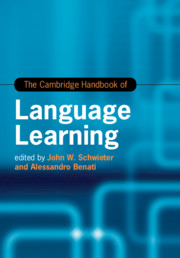Book contents
- The Cambridge Handbook of Language Learning
- Cambridge Handbooks in Language and Linguistics
- The Cambridge Handbook of Language Learning
- Copyright page
- Contents
- Figures
- Tables
- Contributors
- Acknowledgements
- Introduction
- Part I Theories
- Part II Methods
- Part III Skill Development
- Part IV Individual Differences
- Part V Pedagogical Interventions and Approaches
- Part VI Context and Environment
- Part VII Moving Forward
- Index
- References
Part VI - Context and Environment
Published online by Cambridge University Press: 25 June 2019
- The Cambridge Handbook of Language Learning
- Cambridge Handbooks in Language and Linguistics
- The Cambridge Handbook of Language Learning
- Copyright page
- Contents
- Figures
- Tables
- Contributors
- Acknowledgements
- Introduction
- Part I Theories
- Part II Methods
- Part III Skill Development
- Part IV Individual Differences
- Part V Pedagogical Interventions and Approaches
- Part VI Context and Environment
- Part VII Moving Forward
- Index
- References
Summary
Bilingual education is a simple label for a complex phenomenon (Cazden & Snow, 1990). Implemented all over the world, bilingual education (BE) has been a cutting-edge field of research and practice for the past fifty years. Linked to research on bilingualism (and multilingualism) in its interdisciplinary dimensions, the field of BE continues to grow exponentially in the twenty-first century as globalization, migration, and hyperconnectivity among people mean that we use language(s) differently. When most people in the world today use more than one named language to communicate in their everyday life, when so many children come to school with so many different language practices, and when the past fifty years of research have shown the various benefits of BE, it is surprising that BE is not offered more widely. Where do the obstacles lie? Who does BE serve and to what purpose? Which languages are favoured and which are not? How have all the different frameworks and types of programmes been researched? How has the field moved forward to propose more dynamic and transformative pedagogies of BE?
- Type
- Chapter
- Information
- The Cambridge Handbook of Language Learning , pp. 647 - 774Publisher: Cambridge University PressPrint publication year: 2019



